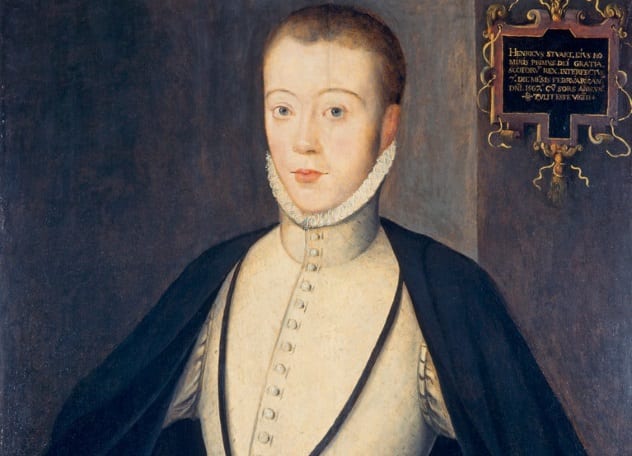 Weird Stuff
Weird Stuff  Weird Stuff
Weird Stuff  Health
Health Ten Confounding New Inventions from the World of Biomedicine
 Creepy
Creepy 10 Death Superstitions That Will Give You the Creeps
 Movies and TV
Movies and TV 10 Movies That Get Elite Jobs Right, According to Experts
 Weird Stuff
Weird Stuff 10 Times Real Laws Were Based on Bizarre Hypotheticals
 Animals
Animals 10 Inspiring Tales of Horses Being Human
 Mysteries
Mysteries Top 10 Haunting Facts About the Ghost Ship MV Alta
 History
History 10 Surprising Stories About the Texas Rangers
 Humans
Humans 10 Philosophers Who Were Driven Mad by Their Own Theories
 Miscellaneous
Miscellaneous 10 Video-Game-Worthy Weapons and Armors from History
 Weird Stuff
Weird Stuff 10 Warning Labels That Exist Because Someone Actually Tried It
 Health
Health Ten Confounding New Inventions from the World of Biomedicine
 Creepy
Creepy 10 Death Superstitions That Will Give You the Creeps
Who's Behind Listverse?

Jamie Frater
Head Editor
Jamie founded Listverse due to an insatiable desire to share fascinating, obscure, and bizarre facts. He has been a guest speaker on numerous national radio and television stations and is a five time published author.
More About Us Movies and TV
Movies and TV 10 Movies That Get Elite Jobs Right, According to Experts
 Weird Stuff
Weird Stuff 10 Times Real Laws Were Based on Bizarre Hypotheticals
 Animals
Animals 10 Inspiring Tales of Horses Being Human
 Mysteries
Mysteries Top 10 Haunting Facts About the Ghost Ship MV Alta
 History
History 10 Surprising Stories About the Texas Rangers
 Humans
Humans 10 Philosophers Who Were Driven Mad by Their Own Theories
 Miscellaneous
Miscellaneous 10 Video-Game-Worthy Weapons and Armors from History
Top 10 Historical Whodunits Worthy Of Sherlock Holmes
If the enduring popularity of Sherlock Holmes has showed us anything, it’s that people have always enjoyed a good murder mystery. Perhaps if Sir Conan Doyle’s super-sleuth had been around to lend a helping hand, these next ten cases might have been solved. As it stands, they have puzzled investigators for decades, even centuries, and it’s unlikely we’ll ever find out the whole truth behind them.
10 The Case Of The Scottish Lord

Henry Stuart, better known as Lord Darnley, was king consort to Mary, Queen of Scots. In 1567, he was living in a church house in Edinburgh called Kirk o’ Field. On February 10, Lord Darnley was bedridden, recovering from a bout of smallpox, although rumors said it was actually syphilis. Early in the morning, the city was rocked by an explosion that absolutely decimated Kirk o’ Field. Darnley’s body was found in an orchard nearby, along with that of his servant. Curiously, neither man had suffered any damage from the explosion. In fact, Darnley appeared to have been strangled to death.[1]
It was later revealed that someone had snuck two barrels of gunpowder into the basement of Kirk o’ Field in the days prior to Darnley’s assassination. Historians believe that Darnley either tried to escape or was simply taking a stroll during the explosion, and his assassin(s) improvised. 16th-century Scottish historian James Melville, however, wrote that Darnley’s attackers took him out of the house, killed him outside, and dumped him in the orchard.
There was no shortage of suspects for the murder, as Lord Darnley was not a popular man. Most intriguing, however, was the debate over whether or not Queen Mary played a role in his assassination. Darnley was more concerned with women and drinking than he was with royal matters. He was also violently jealous and once had Mary’s private secretary, David Rizzio, stabbed to death in her presence. That’s why many believed that another of Mary’s confidantes, Lord Bothwell, orchestrated the murder plot, although he was acquitted.
9 The Case Of The Expired Violinist

18th-century French artist Jean-Marie Leclair the Elder was a man of many talents: dancer, ballet master, musician, and composer. Mostly, it was his skill with the violin that earned him his reputation as one of the best musicians in Paris.
The last years of Leclair’s life were full of turmoil. In 1764, the 67-year-old violinist was living in a small house in a dangerous part of Paris. His second marriage had broken down a few years prior, and his wife, Louise Roussel, had left him. On the night of October 22, Leclair was returning home when he was attacked right in front of the door to his house.
His body was found the following morning. The composer had been stabbed three times in the chest. Police initially suspected the man who found the body: Leclair’s gardener, Jacques Paysant. They reasoned that since Leclair was stabbed in the front, he likely knew his attacker. Afterward, they turned their attention to other people in the violinist’s life with reason to want him dead.
Police came up with two suspects. First was Francois-Guillaume Vial, Leclair’s nephew. The two often quarreled over Vial’s failed career as a musician, and people speculated that Vial resented his uncle. Other investigators, both contemporary and modern, felt that the ex-wife was the better suspect. Not only did her relationship with Leclair end badly, but Roussel was in financial trouble and profited from Leclair’s death.[2]
8 The Case Of The Killer At Kendall Hall

On a Sunday night in September 1977, campus police at the College of New Jersey were doing their routine patrol when they reached Kendall Hall and noticed a bicycle still chained near the entrance. This was shortly before midnight. All external doors were locked, and nobody was supposed to be inside. An officer went inside to check and found a blood trail leading to the main stage, where he discovered the naked, bloody body of a woman.
Her name was Sigrid Stevenson, a 25-year-old student from Livermore, California. She had been beaten to death. Her skull was fractured, and she had many cuts and bruises on her body. Investigators never established exactly what she was doing in Kendall Hall. She could have been sleeping there or going to meet someone. Her acquaintances suggested it was likelier that Sigrid, a passionate pianist, stayed late to play the piano.[3]
Police questioned over 100 people and subjected many to lie-detector tests. They also searched the nearby lake hoping to find a murder weapon. Their efforts produced no tangible leads, and no suspect has ever been named in the murder of Sigrid Stevenson.
7 The Case Of The Rock Island Wreck

On August 9, 1894, a locomotive carrying two passenger cars derailed off a 12-meter (40 ft) trestle in Lincoln, Nebraska, killing 11 people. An inspection quickly revealed that the wreck was the result of sabotage. Spikes had been pulled out of the track, ties had been gouged with a crowbar, and the rail had wrench marks. This act of sabotage was the largest mass murder in the history of the state, alongside Charles Starkweather’s 1958 killing spree.
A black man named George Washington Davis was arrested two days later. Witnesses claimed to have seen him with a lantern at the crash site.[4] He was convicted during a second trial but was paroled ten years later by Governor John Mickey. Nobody else was ever charged.
Davis had a lot of support, both then and now, claiming he was nothing but a convenient scapegoat for a community out for punishment. Others believed that he was involved, but he didn’t act alone. The lack of a motive led them to conjecture that Davis might have been hired to sabotage the rail, perhaps by a Rock Island competitor. However, even now, over a century later, all of this remains pure speculation.
6 The Case Of The Vanishing Housewife

Dorothy Cooper’s life seemed idyllic. In 1942, she married her childhood sweetheart, Jules Forstein, who was quickly climbing the ranks of the Philadelphia justice system until he became a judge. The couple had three children together and lived in a luxurious three-story home. Everything was going well until the evening of January 25, 1945, when Dorothy was attacked by an unidentified man. Her assailant was waiting underneath the front stairs and pounced on Mrs. Forstein when she opened the door. She was beaten senseless but wasn’t robbed or sexually assaulted. The attacker was never identified.
Fast-forward four years to the night of October 23, 1949, when Judge Forstein had to attend a political banquet. He returned home to find his two youngest children crying that “mommy was gone.” Nine-year-old Marcy Forstein saw a man enter her parents’ bedroom. When she peaked inside, she saw Dorothy lying on the floor in her red pajamas and the man hoisting her on his shoulder.[5]
Marcy’s testimony was the only clue police had to go on. Dorothy Forstein was never seen again, nor was her kidnapper identified. The case has attracted its fair share of professional and amateur sleuths. Most of them believed the mysterious attacker was a criminal seeking revenge against the judge.
5 The Case Of The Rahway Jane Doe

During the early morning of March 26, 1887, four brothers were headed toward the mill in Rahway, New Jersey, when they stumbled upon a gruesome discovery: the body of a young woman left frozen in the mud. She had been badly beaten, and her throat had been slashed repeatedly. Police combed the area and found various items likely belonging to the victim and her assailant. A discarded pen knife was the most likely murder weapon.
The horrific nature of the murder garnered it national press. Hundreds of people came to view the body or to offer potential leads, but none of them brought police closer to catching the killer or even identifying the victim.
A break in the case came when a man named Kasper Shumbeck confessed to the crime.[6] He claimed that he killed the young woman with the help of a Swedish friend named John. One bludgeoned her with a club, and the other cut her throat. However, after interrogating him in Rahway, police concluded that his confession was false.
The case was never solved, and the victim remains a Jane Doe. The mystery is of particular interest to some ripperologists. They point to Francis Tumblety, medical quack and Jack the Ripper suspect, who was living nearby in New York when the murder happened.
4 The Case Of The Bludgeoned Businessman

A successful investor and a dedicated philanthropist, Benjamin Nathan was one of New York City’s Jewish elite during the 19th century. On the morning of July 29, 1870, two of his sons, Frederick and Washington, found Nathan’s bloody body outside the office of his lavish four-story brownstone. He had been viciously assaulted the night before with an iron bar that was left at the scene, and his skull had been split in six places.[7]
The initial hypothesis suggested that Nathan’s death was the result of a burglary gone bad. The thief sneaked into the house during daylight hours, waited until dark, and then attempted to break into the office safe. Nathan heard a noise, went to investigate, and stumbled upon the burglar. A fight ensued, and the criminal killed Nathan using whatever weapon was handy. While a plausible scenario, it failed to answer certain questions, such as why nobody in the house heard the violent struggle.
Some began to suspect Nathan’s 22-year-old son, Washington. He was known to live an extravagant lifestyle filled with excesses. In fact, he brought a prostitute named Clara Dale to testify to his whereabouts.
Although he was never charged with anything, Washington Nathan remains a suspect in his father’s murder to this day. Some people felt he used his wealth and influence to escape justice. Others believed in his innocence and pursued other leads, such as a safecracker named Billy Forrester. He allegedly shared his role in Nathan’s murder with a fellow criminal named George Ellis, who, in turn, told the cops while incarcerated at Sing Sing.
3 The Case Of The General’s Granddaughter

Elsie Sigel was a model citizen who came from a good family. Her grandfather, Franz Sigel, was a decorated general in the Civil War. Her mother taught Sunday school, and Elsie did missionary work in New York’s Chinatown. Therefore, when she went missing in June 1909, her disappearance garnered a lot of interest. That interest turned to horror when Elsie Sigel was found ten days later, strangled to death and stuffed inside a trunk in Chinatown.
The immediate suspect was the owner of the trunk, a Chinese waiter named Leon Ling. After all, the trunk was found in his locked apartment. The smell caused police to break down the door, convinced they would find the dead waiter inside. Instead, they discovered the naked, decomposing body of a young woman. Her features were almost unrecognizable, but police also found a bracelet with Elsie’s initials.[8]
Investigators uncovered dozens of love letters proving the two were having an affair. In those days, the romance between a white woman from a respectable family and a Chinese immigrant shocked the public almost as much as the murder. The shock increased when police revealed that Elsie was also seeing another Chinese man named Chu Gain.
Police believed that Ling killed Sigel out of jealousy. However, it was never proven, as the waiter successfully disappeared. Some people believed the real culprit killed both Ling and Sigel and then framed the waiter. It could have been Chu Gain, somebody else Elsie was seeing, or white supremacists angered by their relationship. It was also speculated that the dead woman was a look-alike and that the real Elsie ran away with Ling.
2 The Case Of The Atlanta Ax Murders

Today, the name DeFoor is prominent in Atlanta. Two roads and several businesses share this name, honoring one of the city’s early settlers, Martin DeFoor. He took over and operated one of the oldest ferries over the Chattahoochee River, which eventually came to be known as DeFoor’s Ferry. Despite his considerable presence, few people today remember the brutal murder of Martin DeFoor and his wife or that their killer was never brought to justice.
On the morning of July 26, 1879, DeFoor’s grandson, Martin Walker, was passing by their home. Realizing it was unusual for them to still be sleeping, Walker went in to check on them. Inside, he found a bloody scene. Both his grandparents had been attacked and almost decapitated by the violent swings of an ax that was left in the fireplace.
Investigators had trouble determining if robbery was the primary motive or not. DeFoor’s wallet and boots were stolen, but other valuables, including $18 in silver, were left untouched. More curious was the fact that the perpetrator(s) spent time in the home before the murders. The upstairs bedroom was full of muddy footprints, the bed was slept in, and someone defecated in the lumber room next door.
The only solid lead came four years later, when a man named Joe Johnson confessed to the crime in his sleep, and his girlfriend alerted authorities.[9] Johnson implicated two other men as his accomplices, but in the end, police dismissed his confession as false.
1 The Case Of The Three Trappers

During the winter of 1924, three men from Bend, Oregon, decided to spend the season in an isolated log cabin near Lava Lake and do some fur trapping. Those men were Edward Nichols, Roy Wilson, and Dewey Morris.
Come spring, some of their friends and family ventured to the cabin to check on the men. They found an abandoned house and patches of blood leading toward the lake. It wasn’t until the ice melted that they were able to see the true gruesomeness of the event. All three men had been shot, butchered, and dumped in the lake under the ice.[10] It appeared as though they had been taken by surprise because Nichols, although missing part of his chest and lower jaw from a shotgun blast, was still wearing his reading glasses.
While looking for motive, police discovered Lee Collins, another trapper who’d had an argument with Nichols over a missing wallet and threatened to “get even.” A little more digging revealed that Collins was actually Charles Kimzey, a man with a previous arrest for robbery and assault. However, investigators didn’t believe Kimzey alone could have dispatched the three men that quickly and effortlessly, even with the element of surprise.
It took five years before police finally apprehended Kimzey, only for him to be acquitted due to insufficient evidence. The gruesome case remains unsolved with several lingering questions: Was Kimzey involved? Did he have a partner? If not him, then who?








